Apodytes dimidiata
| Botanical Name | Apodytes dimidiata |
|||||||||||
| Family | Icacinaceae - The white pear family. |
|||||||||||
| Pronunciation | ay-po-DYE-tees dye-mid-ee-AY-tuh |
|||||||||||
| Common Name(s) |
English: White pear; Bird's-eye Tree
Afrikaans: Witpeer
IsiXhosa: umdakana; umdakane; Umkhwenkwe
IsiZulu: UmDakane
Sesotho sa Leboa: sephopha-madi; Kgalagangwê
Tshivenda: Tshiphopha-madi
|
|||||||||||
| Plant Group |
|
|||||||||||
| Plant Size |
|
|||||||||||
| Position |
|
|||||||||||
| General Information |
|
|||||||||||
| Specific Information | With non-invasive roots, glossy, bright green leaves and no messy fruits, this small, bushy tree is an excellent choice for the garden, providing deep shade all year long. The small flowers are fragrant and the fruits have a scarlet 'aril' attached, which make them an added attraction. Apodytes dimidiata is a protected tree in South Africa. |
|||||||||||
| Ad Break | ||||||||||||
| Flowers | ||||||||||||
| Description | profuse, loose clusters of tiny, fragrant blooms at the ends of branches |
|||||||||||
| Season |
|
|||||||||||
| Colour |
|
|||||||||||
| Growth Rate |
|
|||||||||||
| Plant Uses |
|
|||||||||||
| Distribution and Habitat | from Table Mountain in the Cape Peninsula, along the coast through the Eastern Cape and KwaZulu- Natal and in Gauteng as well as Swaziland and Kenya, in coastal forests, on the margins of evergreen forests, in open woodlands and on grassy mountain slopes, often among rocks |
|||||||||||
| Planting Suggestions | Apodytes dimidiata thrives in well-drained, compost-rich soil. Young plants grow slowly, but they will grow faster as they grow bigger. Protect against frost for the first year. The old method of digging a deep hole and filling it with soil and compost has resulted in many trees failing to thrive, dying, rotting at the base or worse still, falling over in later years due to poor root development. Refer to the following sites for the best method of planting trees: International Society of Arboriculture: New Tree Planting Tree People: Plant the right way For those of you who have a clay problem try: |
|||||||||||
| Medicinal Uses | This tree is valued by the Zulu nation: An infusion from the root bark is used as an enema for intestinal parasites and the leaves are used in the treatment of ear inflammation. |
|||||||||||
| Ad Break | ||||||||||||


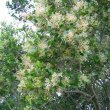
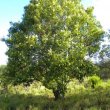
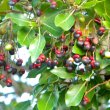
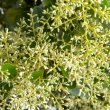
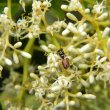
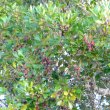
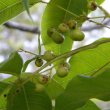
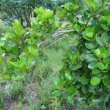

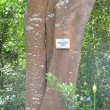


Comments
apodytes dimidiata
Hi there
The leaves on my white pear are going black. It is only a sapling, planted a few months ago. There is some new growth but the lower branches which are only thin have died. Any thoughts Regards Bob
White pear not thriving
Hi Bob
I'm going to need a bit more information here - a picture of the whole sapling and a close-up of the leaves would be best.
By leaves turning black do you mean that they a going black and crispy, or is there a sort of sooty black substance covering the leaves? It would also be useful to know where you stay.
Kind regards
Lorraine
White Pear with some black leaves
Hi Lorraine
I too have a sapling with some leaves turning black and falling off.
I have harvested about 200 seedlings from around my mature Apodytes Dimidiata and want to let them reach 3.00 meters before offering them for sale.
The sapling in the picture was bagged about 18 months ago. Not all the saplings are affected. Could it be too strong a chicken manure mix? I am in Constantia. No frost yet.
Regards
Mickey
Browning leaves on White pear
Hi Mickey
Apologies for taking so long to reply.
The leaves do appear to be burn't rather than diseased. If the chicken manure was mixed in with the soil in the bags 18 months ago, the problem should have shown up within a few weeks of planting. If you have added chicken manure or tea more recently then this would be the most likely reason for the leaves browning.
Alternatively:
The leaves may be sunburnt but then all the plants would be affected.
The leaves have one or other form of rust but this shows up with small, dark brown spots all over the leaf which eventually join together. The rust spots also show up on both sides of the leaf.
Chicken manure, being very high in nitrogen, is known to have this burning effect and needs to be used in very small quantities. If this is the most likely cause, I would soak the affected pots in a bath of water for a few hours and then drain them so as to leach out as much of the offending nitrogen as possible.
Kind regards
Lorraine
Browning leaves on White pear
Hi Lorraine
Thanks so much for your reply. The problem was indeed chicken manure that had been sprinkled on top unbeknown to me by a well meaning person. All well now. I have about 300 healthy growers with lots more to harvest!
Regards
Mickey
apodytes dimidiata
Hi Lorraine
Will send you photos tomorrow but in the meantime, I stay in Stilbaai and yes, they are going black and crispy starting at the top and spreading down and then shrivelling away. No sooty black substance. I can tell you that we get a lot of wind here and the sapling IS exposed. Also the locals complain about the quality of the soil in the harbour area where we are. Bob
Apodytes dimidiata
Hi Bob
I Googled the harbour area of Stilbaai and with your description of the leaves, I have a very strong feeling that your tree is being burned by salty winds. Although this tree grows naturally along the coast, it is only found in coastal forests, on the margins of evergreen forests, in open woodlands and on grassy mountain slopes, in relatively good soil. It has no defence against either salt spray or the salinity within the soil itself. I have serious doubts as to the longevity of your poor, sad little tree.
There are a limited number of trees that can tolerate saline situations. I have e-mailed you a list of the type of trees you could use.
Kind regards
Lorraine
Saline conditions.
Hello Lorraine, Would you be so kind as to email me that list of trees that will tolerate saline, windy conditions. I live up the road from Bob in Dana Bay and would like to plant some stuff.... I also have an apodytes dimidiata, which is in a sheltered place in a pot now and seems alright :) Hope it stays that way.
Many thanks.
Suzie
Plants for coastal gardens
Hi Suzie
I have emailed the list to you with the reminder that the list was designed with the Eastern Cape in mind so there will be many more fynbos and other species you could use that are not listed, while others on the list may not be happy with winter rainfall.
Kind regards
Lorraine
Thank you for your help on
Thank you for your help on the white pear, Lorraine ,even though it was bad news. Your list of trees will be a big help. We learn as we go along. Will keep in touch. Bob
Ailing Apodytes
Hi Bob
I have posted your pictures above so that the comments can be useful to others.
I do notice that you have put down a little bit of mulch around the base of the tree. With your poor quality of soil I would use a much thicker layer of mulch, 10 cm deep and about a meter all round the tree. This helps to keep a lot more moisture in the area, encourages roots to venture further, keeps the roots cooler, feeds nutrients into the soil and over time alters the quality of the soil. I add mulch over this layer as it thins out. Keep the immediate area at the base of the trunk clear of mulch to prevent fungal problems.
Having also come from the Highveld, it came as a shock to realise how easy it was to have a great garden there compared to the poor soils, windy conditions and different rain patterns we experience at the coast.
Do keep in touch.
Kind regards
Lorraine
White Pear tree hates the other
Good day
we have planted two white pear trees about 8 meters apart.
The smaller one now seems to hate the bigger one as it is leaning away from the bigger tree. We tried to put a stake in to keep it up straight, but to no avail. Are the trees to close together? We really want to create a forest effect but it does not seem to work
Staking a young tree
Hi Letisha
Eight meters apart sounds reasonable. You haven't mentioned how tall the trees are, for how long you staked the tree or the method you used to stake the tree. It would also help to have a clearer idea about the difference in size between the two trees. This information and an image would help to make a better diagnosis so I am just going to make some general suggestions.
It may be that the root ball was placed or has shifted position so that it is causing the tree to lean over. Unless the tree is very young I would be hesitant to dig it up to correct this.
It appears that to straighten the tree you may need to stake it. The following sites will give you the do's and don'ts for staking a tree correctly and for how long to leave the stake before removing it.
http://www.gardeningblog.net/2009/05/20/how-to-stake-a-tree/
http://homeguides.sfgate.com/stake-small-leaning-tree-65075.html
If the smaller tree is very much smaller and is not thriving, it may be a better idea to remove the smaller one (it may simply be a 'dud') and replace it.
Hope this helps.
Kind regards
Lorraine
Discuss this plant
Share knowledge, ask a question or give an experience.